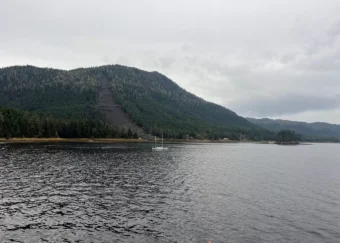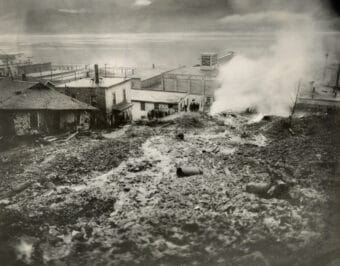
WRANGELL — By Nov. 20, rain had been pouring down on Wrangell for days. It grew even stronger in the late afternoon as Angie Flickinger drove to her house on Zimovia Highway, a road that follows the coast for 14 miles south from downtown.
Around mile eight, she saw water cascading from the steep bluffs above the road. She raced through that stretch nervously, worried about the rockfalls that happen there.
“That type of weather always gives me tons of anxiety,” Flickinger said. “There always seems to be this big storm at the end of November, where trees fall. There’s always carnage.”
Later that night, the rain pounding on her roof sounded like white noise. Then it changed suddenly.
“I heard this very loud sound. Like it had been amplified tenfold,” Flickinger said. “My brain was like, ‘That’s not right.’”
Flickinger’s friend Jamie Roberts lives about a half-mile up the road. To her, the sound was like a jet rumbling overhead. She opened the door to look, and the sound got louder.
“I yelled at my husband, and I was like ‘Alaska Airlines, something is wrong with the jet, it’s coming down,’” Roberts said.
She braced herself for the sound of a crash, but it never came. Instead, the whole house started shaking.
“And we just ran out the door,” she said.
A few hundred feet away, Roberts’ neighbor Christina Florschutz was on the second floor of her house, just out of the shower. She knew what the sound was. She’d heard mudslides before.
“Suddenly I’m like a piece of weightless popcorn being tossed around all over the place,” she said. “And then — I don’t remember anymore for a while.”
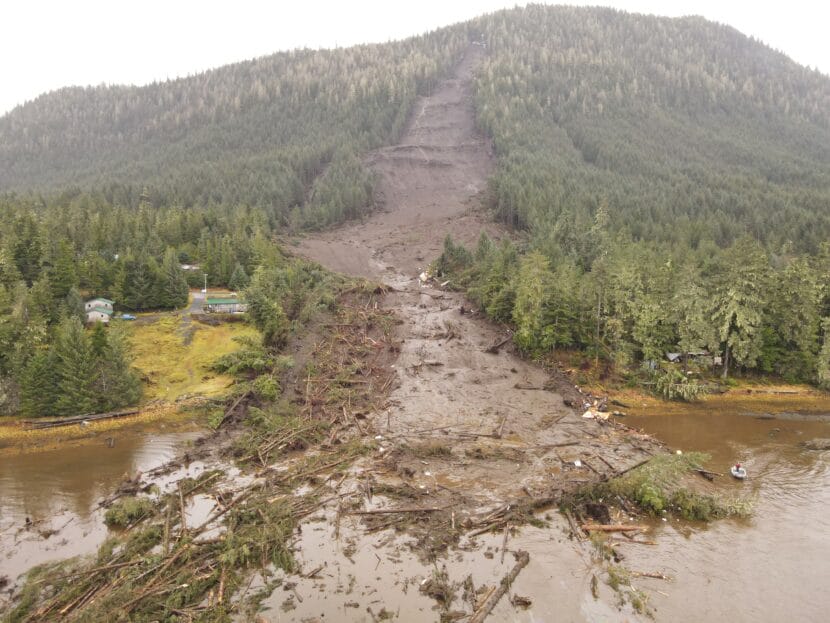
The landslide
That evening, a burst of heavy rain drenched the already sodden hillside around mile 11 of Zimovia Highway while 70 mph gusts battered the trees. Eventually, parts of the slope were more water than soil. The earth finally gave way at about 8:45 p.m.
A viscous flow of mud roared down toward the road, carrying hundreds of fallen trees. It picked up the Florschutz house and carried it downhill until it slammed into the family’s workshed and fell to pieces. The slide crossed the highway, burying the house where Beth and Timothy Heller lived with their three children. Some of the debris reached the water.
Beth and Timothy Heller were later found dead, as were their daughters, Mara and Kara. Their son Derek has not been found. Searchers found the body of Otto Florschutz, Christina’s husband, on Nov. 30.
It was the deadliest landslide in recent Alaska history. For about 70 people who live beyond the slide zone, it blocked the road and knocked out power for a week. Now, some who live on the hillside wonder if they should leave their homes for good.
KTOO spoke to a dozen people who were stranded beyond the slide zone that night. They described hours of fear and confusion as some fled their homes — and how that confusion gave way to an improvised evacuation where neighbors helped each other to safety.
“We could still hear the hillside cracking”
After the slide came down, Roberts ran to the beach with her husband and son. She could see the silhouette of a big pile of debris just up the coast. And she could smell it.

“Like Christmas wreaths,” Roberts said. “It was a very overwhelming, you know, conifer smell.”
Roberts was close with the Florschutzes and the Hellers. They’d celebrated holidays together, and Roberts had coached the younger Heller children at swimming. From what she could see, the slide had plowed right through their properties.
She was shaken and didn’t know where to go. Her family stood in the rain wearing just the clothes they escaped in. Her husband was barefoot. The rain was soaking through their sweatshirts, but they were afraid to move.
“We could still hear the hillside cracking,” Roberts said. “So we figured if we just stand in this one spot and are quiet, we’ll be able to know which way to go if more starts coming down the hill.”
Angie Flickinger, Roberts’ neighbor to the south, didn’t know what had happened. The power had gone out, but she was still in her house.
She stepped outside to investigate, thinking a small slide might have come down close by. That had happened two years ago, during a November storm that snapped utility poles and knocked down dozens of trees.

She couldn’t see much of anything with her headlamp. The roaring had died down, but the two creeks that run through her property were raging, and the wind was shaking the trees.
She tried to reach friends who might know more, but she couldn’t get through to anyone. She thought she might just go to bed, but as she was putting pajamas on, at 9:30 p.m., the phone rang.
“It was a friend in town,” Flickinger said. “And she told me that there had been a big slide. Like a major slide.”
Just then, something caught Flickinger’s eye out the window. A boat with piercing white lights was charging up the coast.
A risky search
Search and rescue teams arrived quickly, just after 9 p.m. by road on the north side of the slide, and soon after that by boat. In the pitch dark, they made a hasty search and recovered the body of the Heller’s 16-year-old daughter, Mara.
But the mud was deep and soft — rescuers who tried to climb the debris sank to their chests. Like the Roberts family, they could hear the unstable hillside shifting in the dark. Before long, they called off the search for the night.
About a mile away, Charlie and Mel Hazel saw the search boats, too. A retired couple, they live at mile 12.7 in a house they built 10 years ago.
“Great big, huge sodium lights. And they were up here, kind of going around in circles,” Hazel said, pointing to the water north of his property.
They watched the lights through the windows of their darkened living room. Then some of the lights started moving their way.
“That boat came down here and landed on my dock,” Hazel said. “Then a search and rescue team got off.”
They told the Hazels about the landslide. Charlie Hazel gave them the keys to his pickup truck, and they tore off down the road.
Back in town, Eric Yancey was firing up his private ferry, the Rainforest Islander. He had learned about the slide from his brother-in-law, who took his fishing boat out to help light the search. Yancey wasn’t sure where he was going or how his ferry might be used — he just wanted to help somehow.

“I didn’t know what I was doing”
Flickinger — and many others — also were not sure what to do or where to go.
“I didn’t really know the full severity of it,” Flickinger said. “I didn’t know what I was doing.”
Cell reception that far out of town is always unreliable, and the slide had taken out landlines and internet along with the electricity.
At 9:36 pm, the city had sent out a text and email alert saying a landslide had happened between miles 10 and 12 — and they sent several more updates through the night. But it’s likely that most people never got them. According to the Wrangell’s interim borough manager, only 10% of residents are signed up for the city’s emergency alert system.

Out the road, the houses are spread out, and many have long driveways through large, wooded yards. In the dark, it took hours for firefighters to spread the evacuation warning.
Meanwhile, people wandered up and down the road, in cars and on foot. A few went to the slide with flashlights and hand shovels. Some even tried to climb over it, but they retreated once they realized just how far the debris stretched.
Others went back to their houses, packed their bags and waited. Some listened for more slides, ready to make a quick escape.
Flickinger started walking toward the slide, too, but her neighbors up the road pushed her back. They urged her to go to the school bus turnaround — a flat place near the toe of the mountain where many had already gathered.
But Flickinger was worried about her neighbors. She knew the slide had come down near the Roberts’ house, and she hadn’t heard from them. She also thought of a young family down the road. She knocked on their door, but they didn’t answer.
Thinking she might be overreacting, she started to head back home. That’s when a truck full of firefighters stopped her. They told her to leave the area and head to Charlie Hazel’s dock.
For Flickinger, that’s when fear fully set in.
“So I turned around, went back to my friend’s house,” she said. “I screamed and flashed my headlamp in all their windows and doors until they woke up.”
The Roberts family finally ventured up from the beach. They walked toward some lights on the highway, where they found a group of firefighters that told them to go to Hazel’s house. They dashed into their house for some shoes, grabbed their car, and got out of there.

“We were all already grieving”
By then Yancey, the ferry captain, had also gotten word to go to Hazel’s dock. In the wind and rain, the trip took longer than usual. Charlie Hazel described “flat rain” and 35 mph gusts lashing his house as more and more people showed up.
“Everything got pretty crowded with parked cars, and one thing or another. Unloading children and wives and dogs and dog kennels,” Hazel said.
More than half a dozen people had settled in by the Hazel’s wood stove. Not knowing what else to do, Charlie and Mel did their best to feed them.
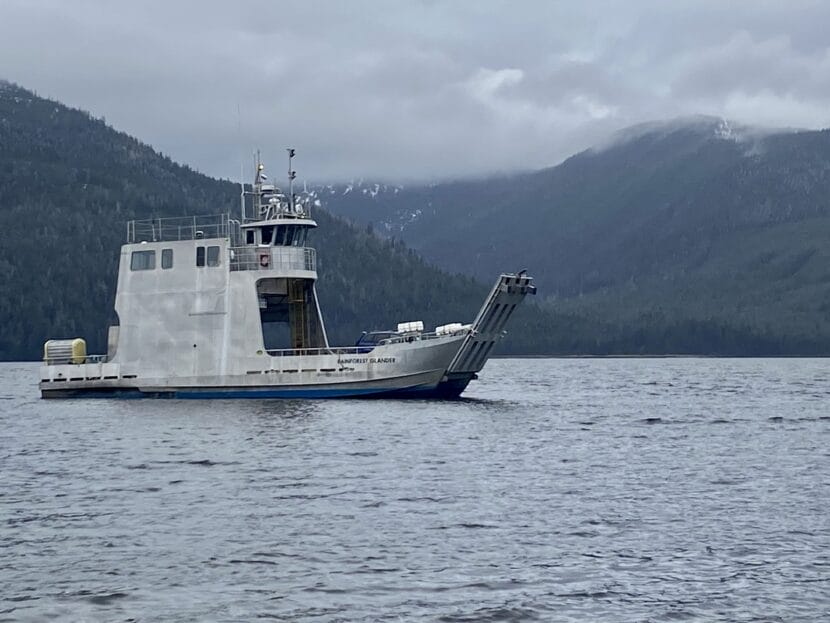
When Flickinger got there, Yancey’s 75-foot ferry was waiting, pinned against the dock by the wind. She boarded and waited in the heated cabin. Roberts found her there.
“Jamie and her family pulled up right after I did,” Flickinger said. “And I just gave her a huge hug and cried on her shoulder.”
Sitting in the ferry, Flickinger, the Roberts and a few other families tried to piece together what happened from snippets of search-and-rescue chatter on the boat’s radio.
“We had heard that a couple of neighbors had been impacted. And that likely wasn’t good,” Flickinger said. “I think we were all already grieving at that point.”
For three hours they waited, on edge and exhausted, bobbing by the dock in the nasty weather. By the time they set off for town, 19 people were on board. They got to Wrangell close to 4 a.m.
“There was a lot of people at the dock when we pulled in, loved ones,” Yancey said. “A lot of hugging.”
Yancey, a 21-year military veteran, spent much of the night focused on the task at hand. At home, in front of the TV, he started to process.
“Small town,” Yancey said. “You’re either related to or know pretty doggone well the people that were involved.”
Robert’s phone was flooded with messages from concerned friends, and from the friends and family of the Hellers and Florschutzes.
“My message was like, I have not seen them,” Roberts said. “The slide went right down the path of where they’re living. It would be a miracle if people were able to make it out of there.”
“They came and got me”
Somehow, Christina Florschutz did. She woke beneath a piece of roof from her destroyed house and kept herself warm with pieces of polar fleece from a bag of sewing supplies.
“I was getting rained on, it was very windy,” Florschutz said. “And I kept telling myself, you can breathe. You can see the trees. You’re not buried. You must be near the top of the pile.”
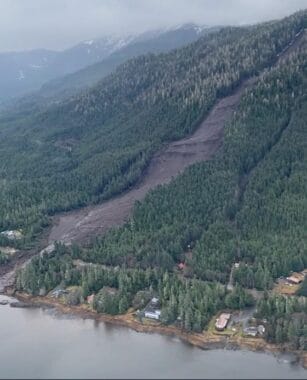
At daybreak, she climbed out and started to make her way across the debris field.
“And I see hats coming through the trees, baseball caps,” Florschutz said. “And they heard me yell, and they came and got me.”
Florschutz says she’ll look for a new home in Wrangell, somewhere on flat land.
Roberts will be looking for a new house, too. At the base of the hill, her little A-frame home now stands frighteningly close to a pair of slide paths — the enormous, fresh gash to the north, and the duller scar of an older slide that stopped just short of her property.
Now, she can hardly stand to be in her house for more than a few minutes.
“We’ve owned our property for a long time. It wasn’t in our plans to ever move and build a new house, nor could we,” Roberts said. “But I just keep being like, I’m alive. And I have my family. And the rest, we’ll just figure it out.”
KSTK’s Colette Czarnecki and Wrangell Sentinel’s Caroleine James contributed reporting.

